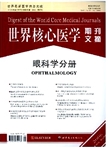简要分析泪囊闪烁照相术的临床应用价值
Clinical value of dacryoscintigraphy using a simplified analysis作者机构:Department of Nuclear Medicine University Hospital Groningen Groningen Netherlands
出 版 物:《世界核心医学期刊文摘(眼科学分册)》 (Digest of the World Core Medical Journals:Ophthalmology)
年 卷 期:2006年第2卷第5期
页 面:35-36页
学科分类:1002[医学-临床医学] 100212[医学-眼科学] 100214[医学-肿瘤学] 10[医学]
主 题:临床应用价值 泪囊 受试者操作特征曲线 照相术 闪烁照相 吸收能力 高锝酸钠 可重复性 泪道阻塞 正常人
摘 要:PURPOSE: To study the discriminatory ability of dacryoscin-tigraphy in differentiating between patients with epiphora and volunteers using a simple method. Methods: Twenty eyes in ten volunteers and 66 eyes in 55 patients with severe epiphora were studied. Dacryoscintigraphy (15 frames of 1min)was performed after administration of 4 MBq 99m Tc-pertechnetate (10 μl) in both eyes. By mapping a single region of interest (ROI)-over the conjunctival sac we determined T1 (%dose in first minute) and linear clearance rate (LCR, defined as 100%(T1-T15)/T1 from the tracer disappearance curve. Reproducibility was determined in volunteers. Conjunctival resorption was determined from completely obstructed systems. Sensitivity and specificity were calculated and receiver operating characteristics (ROC) analysis was conducted. Results: In volunteers mean T1 was 52.8±11.9%(95%CI 47.1-58.4%), and LCR was 74.2±11.1%(95%CI 69.0-79.4%). Reproducibility was good (mean difference 4.1±13.3%for T1 and 0.7±17%for LCR). Epiphora patients had clearly higher T1 (82.1±15.2%, P 0.0001) and lower LCR (38.9±22.5%, P 0.0001) values. Tracer resorption was 24%. Based on ROC analysis 70%for T1 and 50%for LCR were considered optimal cut-off levels to separate patients from volunteers. Sensitivity/specificity were 77/95%for T1 and 71/100%for LCR. T1 and LCR values did not correlate with symptomscores or Anel test results. Conclusion: Dacryoscintigraphy, using LCR and T1 as parameters, is a reliable and objectivemethod to detect tear-flow abnormalities.



